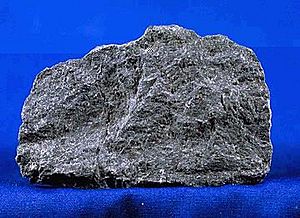Mafic facts for kids
The word mafic describes certain types of minerals and igneous rocks. These rocks and minerals are rich in magnesium and iron. The word "mafic" comes from combining "magnesium" and "ferric" (which means iron).
Mafic minerals are usually dark in color. They are also quite dense. Some common mafic minerals found in rocks include olivine, pyroxene, amphibole, and biotite. Important mafic rocks are basalt and gabbro.
Contents
What Makes Mafic Rocks Special?
Mafic rocks are different from felsic rocks. Felsic rocks have a lot of silica. Mafic rocks have less silica but more magnesium and iron. Think of it like a spectrum. Mafic rocks are on one end, and felsic rocks are on the other.
Mafic Lava and Volcanoes
When mafic rocks melt, they form lava. This mafic lava is not very thick or sticky. It flows easily because it has less silica. Imagine honey versus thick syrup. Honey (mafic lava) flows more easily.
Because mafic lava flows easily, gases and water can escape from it slowly. This means that volcanoes made of mafic lava usually erupt more gently. They are not as explosive as volcanoes with felsic lava. Many volcanoes in the ocean, like those in Hawaii, are made of mafic lavas.
Types of Mafic Rocks and Their Textures
Mafic rocks can look different depending on how they cool. The way a rock looks, like its grain size, is called its texture.
Gabbro: A Coarse-Grained Mafic Rock
Gabbro is a mafic rock that cools slowly underground. This slow cooling allows large mineral crystals to grow. So, gabbro has a coarse-grained texture. This means you can see the individual mineral grains with your eyes.
Basalt: A Fine-Grained Mafic Rock
Basalt is another common mafic rock. It forms when mafic lava erupts onto the Earth's surface and cools quickly. Because it cools fast, the mineral crystals don't have much time to grow large. This gives basalt a fine-grained texture. You usually can't see the individual grains without a magnifying glass.
Other Basalt Textures
- Porphyritic basalt has some large crystals mixed with many small ones.
- Vesicular basalt has small holes from gas bubbles that escaped as the lava cooled.
- Amygdaloidal basalt has these holes filled with other minerals.
- Scoria is a very bubbly basalt, full of many small holes. It's often reddish-brown.
- Some mafic rocks can even be glassy, like Tachylyte, if they cool extremely fast.
Other pages
See also
 In Spanish: Máfico para niños
In Spanish: Máfico para niños


